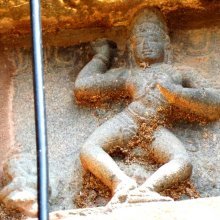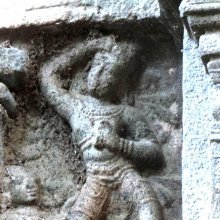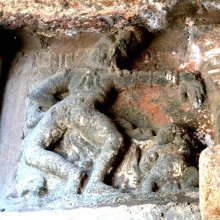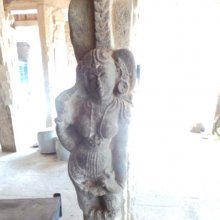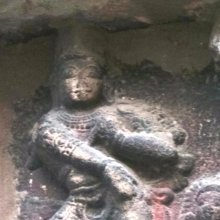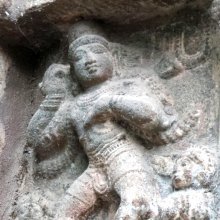Caturashra, Catur-ashra, Caturaśra: 21 definitions
Introduction:
Caturashra means something in Buddhism, Pali, Hinduism, Sanskrit, Jainism, Prakrit. If you want to know the exact meaning, history, etymology or English translation of this term then check out the descriptions on this page. Add your comment or reference to a book if you want to contribute to this summary article.
The Sanskrit term Caturaśra can be transliterated into English as Caturasra or Caturashra, using the IAST transliteration scheme (?).
Alternative spellings of this word include Chaturashra.
Images (photo gallery)
(+4 more images available)
In Hinduism
Natyashastra (theatrics and dramaturgy)
Source: Wisdom Library: Nāṭya-śāstra1) Caturaśra (चतुरश्र, “square”).—One of three main types of playhouses, according to the Nāṭyaśāstra 2.7-8. According to the Nāṭyaśāstra 2.86-92, “ A plot of land, thirty-two cubits in length and breadth, is to be measured out in an auspicious moment, and on it the playhouse should be erected by experts in dramatic art. Rules, definitions and propitiatory ceremonies mentioned before [in case of a playhouse of the oblong (vikṛṣṭa) type] will also apply in case of that of the square type”
2) Caturasra (चतुरस्र) refers to a gesture (āṅgika) made with ‘dance hands’ (nṛttahasta), according to the Nāṭyaśāstra chapter 8. The hands (hasta) form a part of the human body which represents one of the six major limbs (aṅga) used in dramatic performance. With these limbs are made the various gestures (āṅgika), which form a part of the histrionic representation (abhinaya).
(Instructions of Caturasra): Two kaṭakāmukha hands held forward eight aṅgulīs away from one’s chest, the two shoulders and elbows on the same level. The dance-hands are to be used in forming karaṇas.
3) Caturasra (चतुरस्र).—The Vaiṣṇava Sthāna with the two hands moving about at the waist, and the navel together with the breast raised, is called the Caturasra of the limbs.
4) Caturasra (चतुरस्र) refers to one of the two limbs (aṅga) belonging to Khañjanātkuṭā type of song (dhruvā) defined in the Nāṭyaśāstra chapter 32.9-16. Accordingly, “depending on different conditions, the dhruvās are known to be of five classes”.
Source: archive.org: The mirror of gesture (abhinaya-darpana)One of the saṃyutta-hastāni (Twenty-six combined Hands).—Caturaśra (square): Kaṭaka-mukha hands are held before the chest. Patron deity Varāhi. Usage: churning, Jakkiṇī-naṭana, holding, milking, covering with cloths, wearing pearls, dragging ropes, tying the girdle, tying the bodice, holding flowers, etc., plying the fly-whisk.
Source: Shodhganga: Elements of Art and Architecture in the Trtiyakhanda of the Visnudharmottarapurana (natya)Caturasra (चतुरस्र) refers to one of the thirty Nṛttahastas or “dance hand gestures” (in Indian Dramas), according to the Viṣṇudharmottarapurāṇa, an ancient Sanskrit text which (being encyclopedic in nature) deals with a variety of cultural topics such as arts, architecture, music, grammar and astronomy.—The hasta-mudrās (lit. “hand-gestures”) are very essential to denote some particular action or state in dancing and these mudrās are formed with the help of hands and fingers. In the Viṣṇudharmottarapurāṇa, thirty kinds of nṛttahastas (“dance-hand gestures”) are mentioned. e.g., caturasra. The practice of these nṛttahastas is strictly prohibited in sickness of body, in old age, in fear, drunk and anxiety.

Natyashastra (नाट्यशास्त्र, nāṭyaśāstra) refers to both the ancient Indian tradition (shastra) of performing arts, (natya—theatrics, drama, dance, music), as well as the name of a Sanskrit work dealing with these subjects. It also teaches the rules for composing Dramatic plays (nataka), construction and performance of Theater, and Poetic works (kavya).
Vastushastra (architecture)
Source: Wisdom Library: Vāstu-śāstraCaturaśra (चतुरश्र):—The Sanskrit name for a classification of a ‘temple’, according to the 2nd century Matsyapurāṇa and the Viśvakarmaprakāśa, both featuring a list of 20 temple types. This list represents the classification of temples in South-India.
Caturaśra is found in another list in the Samarāṅgaṇasūtradhāra, chapter 63, where it is listed in the group named Nāgara, containing 20 different prāsādas (temples/buildings).
Source: Brill: Śaivism and the Tantric Traditions (architecture)Caturaśra (चतुरश्र) refers to a “square site” (for the construction of houses), according to the Mohacūrottara (verse 4.234-243).—Accordingly, [while describing the construction of the maṭha]—“[...] In front of the maṭha, leaving a distance of the same [size], [houses should be built that are sized according to] the Siṃhāya in the south, the Vṛṣāya in the west, and the Dhvajāya in the east. Or they may be made as large as the patron wishes. They are on a square (caturaśra) site divided into five [parts along each side]. One should leave the intermediate spaces empty. [...]”.
Source: Shodhganga: Elements of Art and Architecture in the Trtiyakhanda of the Visnudharmottarapurana (vastu)Caturasra (चतुरस्र) refers to one of the hundred types of Temples (in ancient Indian architecture), according to the Viṣṇudharmottarapurāṇa, an ancient Sanskrit text which (being encyclopedic in nature) deals with a variety of cultural topics such as arts, architecture, music, grammar and astronomy.—It is quite difficult to say about a definite number of varieties of Hindu temples but in the Viṣṇudharmottarapurāṇa hundred varieties of temples have been enumerated. For example, Caturasra. These temples are classified according to the particular shape, amount of storeys and other common elements, such as the number of pavilions, doors and roofs.

Vastushastra (वास्तुशास्त्र, vāstuśāstra) refers to the ancient Indian science (shastra) of architecture (vastu), dealing with topics such architecture, sculpture, town-building, fort building and various other constructions. Vastu also deals with the philosophy of the architectural relation with the cosmic universe.
Jyotisha (astronomy and astrology)
Source: Wisdom Library: Brihat Samhita by VarahamihiraCaturasra (चतुरस्र) or Caturaśra refers to “that which is oblongular” [?] and is used to describe certain types of Ketus (i.e., luminous bodies such as comets and meteors), according to the Bṛhatsaṃhitā (chapter 11), an encyclopedic Sanskrit work written by Varāhamihira mainly focusing on the science of ancient Indian astronomy astronomy (Jyotiṣa).—Accordingly, “The comets that resemble clusters of stars are named Gaṇakā Ketus; they are 8 in number and are the sons of Prajāpati. Those that are oblongular [i.e., caturasra] in shape, are 204 in number and are the sons of Brahmā. The comets that resemble clusters of bamboo canes and that are as bright as the moon are named Kaṅkā Ketus; they are the sons of Varuṇa and are 32 in number. When they appear mankind will suffer miseries”.
Source: Wikibooks (hi): Sanskrit Technical TermsCaturasra (चतुरस्र).—Quadrilateral square. Note: Caturasra is a Sanskrit technical term used in ancient Indian sciences such as Astronomy, Mathematics and Geometry.

Jyotisha (ज्योतिष, jyotiṣa or jyotish) refers to ‘astronomy’ or “Vedic astrology” and represents the fifth of the six Vedangas (additional sciences to be studied along with the Vedas). Jyotisha concerns itself with the study and prediction of the movements of celestial bodies, in order to calculate the auspicious time for rituals and ceremonies.
Ayurveda (science of life)
Source: Knowledge Traditions & Practices of India: Agriculture: A SurveyCaturasra (चतुरस्र, “square”) refers to one of the layout designs for gardens and orchards mentioned in the Vṛkṣāyurveda: a Sanskrit text by written by Surapāla that deals with agriculture (kṛṣi).—Surapāla’s text mentions 170 species of plants including trees, shrubs and a few herbs, and deals with the laying out gardens and orchards and growing unusual trees. Layouts included designs such as caturasra (square).

Āyurveda (आयुर्वेद, ayurveda) is a branch of Indian science dealing with medicine, herbalism, taxology, anatomy, surgery, alchemy and related topics. Traditional practice of Āyurveda in ancient India dates back to at least the first millenium BC. Literature is commonly written in Sanskrit using various poetic metres.
Shaktism (Shakta philosophy)
Source: Google Books: ManthanabhairavatantramCaturasra (चतुरस्र) (cf. Svādhiṣṭhāna) refers to a “square (a four sided figure)”, according to Tantric texts such as the Kubjikāmata-tantra, the earliest popular and most authoritative Tantra of the Kubjikā cult.—The Liṅga in svādhiṣṭhāna consists of six parts. It is, in other words, hexagonal. The pedestal in the centre of the Foundation is triangular with a point in the centre. This is reckoned here to be the square (a four sided figure) (caturasra) that is the geometric shape associated with this centre. This composite Liṅga-Yoni is the form Bhairava assumes. It is presented to the gods so that they can worship it and thereby receive its benefits.

Shakta (शाक्त, śākta) or Shaktism (śāktism) represents a tradition of Hinduism where the Goddess (Devi) is revered and worshipped. Shakta literature includes a range of scriptures, including various Agamas and Tantras, although its roots may be traced back to the Vedas.
In Buddhism
Mahayana (major branch of Buddhism)
Source: De Gruyter: A Buddhist Ritual Manual on AgricultureCaturasra (चतुरस्र) refers to a “square (maṇḍalaka)”, according to the Vajratuṇḍasamayakalparāja, an ancient Buddhist ritual manual on agriculture from the 5th-century (or earlier), containing various instructions for the Sangha to provide agriculture-related services to laypeople including rain-making, weather control and crop protection.—Accordingly, [As the Bhagavān said]: “Now I shall teach the offering manual which is auspicious and can bring about any effect. At the time of crop damage the [Nāgas] are agitated. Then the spell-master should prepare a square (caturasra) maṇḍalaka in the middle of the field or forest. Four filled jars should be placed [in the four directions]. Flowers should be scattered. [...]”.

Mahayana (महायान, mahāyāna) is a major branch of Buddhism focusing on the path of a Bodhisattva (spiritual aspirants/ enlightened beings). Extant literature is vast and primarely composed in the Sanskrit language. There are many sūtras of which some of the earliest are the various Prajñāpāramitā sūtras.
Tibetan Buddhism (Vajrayana or tantric Buddhism)
Source: MDPI Books: The Ocean of HeroesCaturaśra (चतुरश्र) refers to a “square (shape)”, according to the 10th-century Ḍākārṇava-tantra: one of the last Tibetan Tantric scriptures belonging to the Buddhist Saṃvara tradition consisting of 51 chapters.—Accordingly: [while explaining the body circle (kāyacakra)]: “[Every Yoginī] has the nature of wisdom and means, dwells in the upapīlava (“near the village border”) [holy site], and is [of] the Level of the Practice of Resolution. These are the twelve circle [deities]. Square (caturaśra) [in shape], this circle has the name of the Emanation Body, [is decorated with] five lines [representing the Fivefold Gnosis] starting with the Mirror-like, and is marked with every [kind of good] characteristic. Sixteen [offerings] are performed by goddesses—[this is] the offering to the four layers [...]”.

Tibetan Buddhism includes schools such as Nyingma, Kadampa, Kagyu and Gelug. Their primary canon of literature is divided in two broad categories: The Kangyur, which consists of Buddha’s words, and the Tengyur, which includes commentaries from various sources. Esotericism and tantra techniques (vajrayāna) are collected indepently.
In Jainism
General definition (in Jainism)
Source: archive.org: TrisastisalakapurusacaritraCaturasra (चतुरस्र) or Caturasrasusaṃsthana refers to “symmetrical bodies” and represents the first spoke (i.e., of the twelve-spoked wheel of time), according to chapter 1.2 [ādīśvara-caritra] of Hemacandra’s 11th century Triṣaṣṭiśalākāpuruṣacaritra: an ancient Sanskrit epic poem narrating the history and legends of sixty-three illustrious persons in Jainism.—(cf. Samavāyāṅgasūtra 155, p. 150. Sthānāṅgasūtra 495, pp. 357-8.)
Caturasra-susaṃsthana is the first and best kind of body—of which there are 6 varieties.
- sama—(the more usual form) is a perfectly symmetrical body.
- nyagrodhaparimaṇḍala—the body is like a banyan-tree; the upper part is symmetrical but the lower does not correspond.
- sādi—the reverse of the second. The lower part is properly formed, but the upper part is not.
- kubja—hunchback. The neck, hands, and feet are property proportioned, but the torso is contracted and misshapen.
- vāmana—usually translated ‘dwarfish’—the reverse of kubja.
- huṇḍa—in which every part of the body is misshapen.

Jainism is an Indian religion of Dharma whose doctrine revolves around harmlessness (ahimsa) towards every living being. The two major branches (Digambara and Svetambara) of Jainism stimulate self-control (or, shramana, ‘self-reliance’) and spiritual development through a path of peace for the soul to progess to the ultimate goal.
Languages of India and abroad
Sanskrit dictionary
Source: DDSA: The practical Sanskrit-English dictionaryCaturaśra (चतुरश्र).—a. (for aśri-sri)
1) four cornered, quardrangular; R.6.1. A quality of gems; Kau. A.2.11.
2) symmetrical, regular or handsome in all parts; बभूव तस्याश्चतुरस्रशोभि वपुः (babhūva tasyāścaturasraśobhi vapuḥ) Kumārasambhava 1.32. (-śraḥ, sraḥ) 1 a square.
2) a quardrangular figure.
3) (in astr.) Name of the fourth and eighth lunar mansions.
Caturaśra is a Sanskrit compound consisting of the terms catur and aśra (अश्र). See also (synonyms): caturasra.
--- OR ---
Caturasra (चतुरस्र).—a. (for aśri-sri)
1) four cornered, quardrangular; R.6.1. A quality of gems; Kau. A.2.11.
2) symmetrical, regular or handsome in all parts; बभूव तस्याश्चतुरस्रशोभि वपुः (babhūva tasyāścaturasraśobhi vapuḥ) Kumārasambhava 1.32. (-śraḥ, sraḥ) 1 a square.
2) a quardrangular figure.
3) (in astr.) Name of the fourth and eighth lunar mansions.
Caturasra is a Sanskrit compound consisting of the terms catur and asra (अस्र). See also (synonyms): caturaśra.
Source: Cologne Digital Sanskrit Dictionaries: Shabda-Sagara Sanskrit-English DictionaryCaturasra (चतुरस्र).—mfn.
(-sraḥ-srā-sraṃ) Four cornered, quadrangular. n.
(-sraṃ) A square. E. catur four, and asra a corner.
Source: Cologne Digital Sanskrit Dictionaries: Cappeller Sanskrit-English DictionaryCaturaśra (चतुरश्र).—[adjective] four-cornered, regular, harmonious; [abstract] tā [feminine]
Source: Cologne Digital Sanskrit Dictionaries: Monier-Williams Sanskrit-English Dictionary1) Caturaśra (चतुरश्र):—[=catur-aśra] [from catur > catasṛ] mf(ā)n. four-cornered, quadrangular, [Kātyāyana-śrauta-sūtra; Kauśika-sūtra; Pāṇini 5-4, 120; Harivaṃśa 12378] etc.
2) [v.s. ...] regular, [Jaina literature; Kumāra-sambhava i, 32] ([Vāmana’s Kāvyālaṃkāravṛtti v, 2, 60])
3) [v.s. ...] m. a quadrangular figure
4) [v.s. ...] a square, [Horace H. Wilson]
5) [v.s. ...] (in [astronomy]) Name of the 4th and 8th lunar mansions, [Laghujātaka, by Varāha-mihira]
6) [v.s. ...] (in music) a kind of measure
7) [v.s. ...] ([scilicet] hasta) a particular position of the hands (in dancing)
8) [v.s. ...] ([plural]) Name of various Ketus, [Varāha-mihira’s Bṛhat-saṃhitā xi, 25]
9) [v.s. ...] n. a particular posture (in dancing), [Vikramorvaśī iv, 41/42 [Scholiast or Commentator]]
10) Caturasra (चतुरस्र):—[=catur-asra] [from catur > catasṛ] for -aśra.
Source: Cologne Digital Sanskrit Dictionaries: Yates Sanskrit-English DictionaryCaturasra (चतुरस्र):—[catura-sra] (sraḥ-srā-sraṃ) a. Four-cornered.
[Sanskrit to German]
Sanskrit, also spelled संस्कृतम् (saṃskṛtam), is an ancient language of India commonly seen as the grandmother of the Indo-European language family (even English!). Closely allied with Prakrit and Pali, Sanskrit is more exhaustive in both grammar and terms and has the most extensive collection of literature in the world, greatly surpassing its sister-languages Greek and Latin.
Kannada-English dictionary
Source: Alar: Kannada-English corpusCaturaśra (ಚತುರಶ್ರ):—
1) [adjective] having four angles (said of a plane figure bound by four sides).
2) [adjective] neatly arranged; kept in an orderly, systematic manner.
3) [adjective] agreeable; suitable; congenial.
--- OR ---
Caturaśra (ಚತುರಶ್ರ):—
1) [noun] = ಚತುರಶ್ರಲಘು [caturashralaghu].
2) [noun] anything (as a geometrical figure, plane area, etc.) that is square in shape.
3) [noun] the border between two countries; frontier.
--- OR ---
Caturasra (ಚತುರಸ್ರ):—[adjective] = ಚತುರಶ್ರ [caturashra]1.
--- OR ---
Caturasra (ಚತುರಸ್ರ):—
1) [noun] = ಚತುರಶ್ರ [caturashra]2 - 2.
2) [noun] (astrol.) the fourth and eighth houses from one’s birth house (in the horoscope).
3) [noun] (dance.) a posture of hands in which the upper arm is thrown outwards at the breast level, the hands brought to the breast with the forefinger and middle finger are bent to touch the tip of the thumb, while the little finger and ring-finger are bent but slight raised (depicting holding a garland).
Kannada is a Dravidian language (as opposed to the Indo-European language family) mainly spoken in the southwestern region of India.
See also (Relevant definitions)
Partial matches: Asra, Catura, Shra, Catur.
Starts with: Caturashralaghu, Caturashrama, Caturashramadharmakathana, Caturashramika, Caturashramin, Caturashramya, Caturashramyadharma, Caturashrata, Caturashraya, Caturasraka, Caturasrasusamsthana.
Ends with: Dirghacaturasra, Dvisamacaturashra, Samacaturasra, Vishamacaturasra.
Full-text (+48): Vishamacaturasra, Caturashrata, Samacaturasra, Dirghacaturasra, Caturasrashobhin, Samacatushkona, Caturasrayana, Caturasraka, Caturashrikri, Ardharecita, Dvimudhaka, Ayatadirghacaturasra, Kalandaka, Dvicaturashraka, Catirakkalli, Dvisamacaturashra, Asra, Dvisama, Malakita, Ayatacaturasra.
Relevant text
Search found 22 books and stories containing Caturashra, Catur-ashra, Caturaśra, Catur-aśra, Caturasra, Catur-asra, Catura-sra; (plurals include: Caturashras, ashras, Caturaśras, aśras, Caturasras, asras, sras). You can also click to the full overview containing English textual excerpts. Below are direct links for the most relevant articles:
Kashyapa Shilpa-shastra (study) (by K. Vidyuta)
4. Fourteen types of Samāśra (Square) Maṇḍapas < [Chapter 4 - Maṇḍapa Lakṣaṇa]
5. Fourteen types of Āyatāśra (Rectangular) Maṇḍapas < [Chapter 4 - Maṇḍapa Lakṣaṇa]
Vishnudharmottara Purana (Art and Architecture) (by Bhagyashree Sarma)
2.2. Hand Postures (c): Nṛtta-hasta < [Chapter 3 - Drama and Dance]
4. The Viṣṇudharmottara-purāṇa and Temple Architecture of India < [Chapter 6 - Modern Relevance of Different Art Forms and Architecture]
Natyashastra (English) (by Bharata-muni)
Chapter V - Preliminaries of a Play (pūrvaraṅga)
Chapter XXXII - The Dhruvā Songs
Vastu-shastra (5): Temple Architecture (by D. N. Shukla)
Chapter 6 - Group C: Nāgara Prāsādas
Chapter 4 - Prāsāda styles (C): Vesara
Stūpas (Shrines for Devotion) < [Chapter 12 - History of Hindu Temples (Prāsādas and Vimānas)]
Gati in Theory and Practice (by Dr. Sujatha Mohan)
Description of Gati as in Saṅgītamuktāvalī < [Chapter 2 - Concept and technique of Gati]
Representation of Gati with Karaṇas and Aṅgahāras < [Chapter 2 - Concept and technique of Gati]
Gaits relevant for sentiments < [Chapter 2 - Concept and technique of Gati]
Vakyapadiya of Bhartrihari (by K. A. Subramania Iyer)
Verse 2.155 < [Book 2 - Vākya-kāṇḍa]
